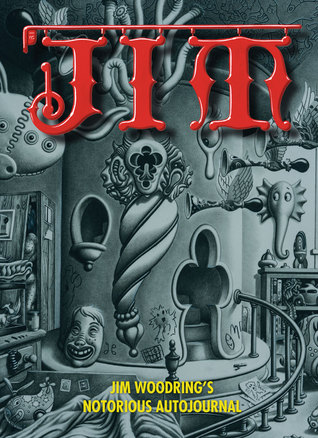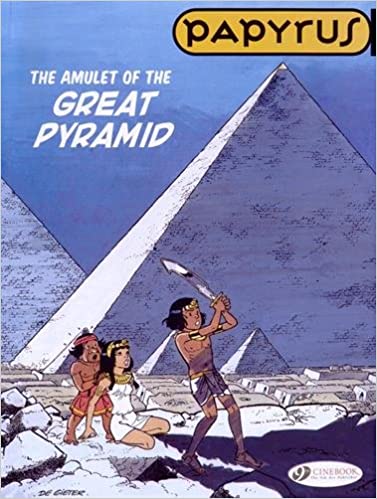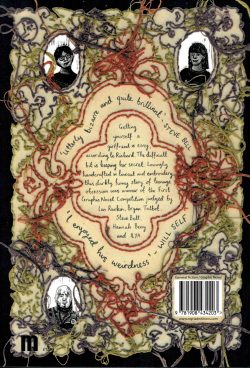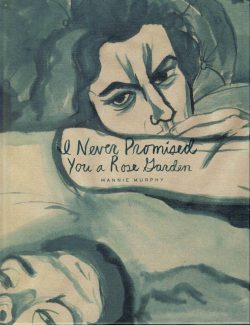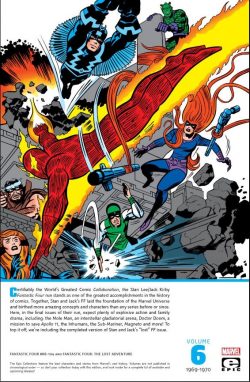
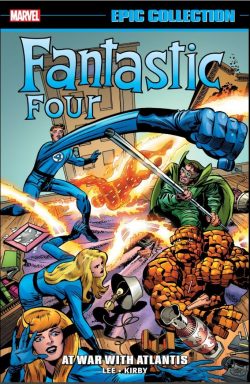
By Stan Lee & Jack Kirby, John Romita, Ron Frenz, Joe Sinnott, Frank Giacoia, John Verpoorten & various (Marvel)
ISBN: 978-1-3029-2202-3 (TPB)
Cautiously bi-monthly and cover-dated November 1961, Fantastic Four #1 (by Stan Lee, Jack Kirby, George Klein & Christopher Rule) was crude: rough, passionate and uncontrolled excitement. Thrill-hungry kids pounced on it and the raw storytelling caught a wave of change starting to build in America. It and succeeding issues changed comics forever. Happy Anniversary!
This epic and extras-packed full-colour compendium – also available in digital editions – gathers issues #88-104 and Annual #7 (cumulatively spanning July 1969 – November 1970) plus Fantastic Four: The Lost Adventure #1 (2008). It covers the final days of the King’s reign on Marvel’s flagship title and shaky transitional start of a new era. And includes diverse bonus treats including a rejected, recovered, recycled tale to delight all aficionados, only finally released in April 2008.
As seen in the ground-breaking premier issue, maverick scientist Reed Richards, his fiancée Sue Storm, their close friend Ben Grimm and Sue’s teenaged brother survived an ill-starred private space-shot after Cosmic Rays penetrated their ship’s inadequate shielding and mutated them all.
Richards’ body became elastic, Sue gained the power to turn invisible, Johnny Storm could turn into living flame whilst tragic Ben shockingly devolved into a shambling, rocky freak. After the initial revulsion and trauma pass, they solemnly agree to use their abilities to benefit mankind and thus was born The Fantastic Four.
Throughout the 1960s the FF was the indisputable central title and most consistently groundbreaking series of Marvel’s ever-unfolding web of cosmic creation: a forge for new concepts and characters at a time when Kirby was in his creative prime and continually unleashing his vast imagination on plot after spectacular plot, whilst Lee scripted some of the most passionate superhero sagas ever seen.
Both were on an unstoppable roll, at the height of their creative powers, and full of the confidence that only success brings, with The King particularly eager to see how far the genre and the medium could be pushed… which is rather ironic since it was the company’s reticence to give the artist creative freedom which led to Kirby’s jumping ship to National/DC in the first place…
And then, he was gone…
Without preamble the magical wonderment resumes with Joe Sinnott inking Fantastic Four #88 which focuses on the five champions (Johnny’s Inhuman girlfriend Crystal had been standing in for Sue who was until recently enjoying a hard-earned maternity leave) back in the USA after defeating Doctor Doom. They are soon looking at an unconventional new house found by determinedly domesticated Mrs. Richards in her perpetual quest to carve out a relatively normal life for her new – and still unnamed – son.
Regrettably the trendy, extremely isolated detached dwelling in ‘A House There Was!’ has been designed by the team’s oldest enemy. No sooner do they all move in than ‘The Madness of the Mole Man!’ turns the deadly domicile against them even as the maniac’s goal of rendering the entire world blind and wiping out the extended heroic family comes within inches of succeeding…
The Thing then takes centre-stage in an extended epic as he is stalked and pressganged to another world when ‘The Skrull Takes a Slave!’ in #90. Abducted to fight in gladiatorial games on a colony world patterned after Earth’s 1920s gangster era, ‘The Thing… Enslaved!’ introduces rival Skrull mobs vying for planetary supremacy and a noble slave destined to slaughter our shanghaied champion. ‘Ben Grimm, Killer!’ efficiently ramps up the tension as Ben Grimm and mechanoid marvel Torgo discover their home-worlds are hostage to their fortunes and ferocity in the arena…
Elsewhere, Reed, Johnny and Crystal have not been idle. While Ben is at ‘The Mercy of Torgo!’ (inked by Frank Giacoia) his Earthly comrades are enacting a desperate plan to swoop in, save him and destroy the Skrulls doom-weapon… a task undertaken and accomplished with great speed and in stunning style…
Fantastic Four #94, began a string of single-issue stories with the doom-laden debut of eldritch babysitter/governess Agatha Harkness in ‘The Return of the Frightful Four!’. The eponymous recalcitrant rogues make a major mistake believing they can catch the FF off-guard by attacking while the heroes are interviewing a new nanny for the latest addition to the Fantastic Family…
At a time when superhero sales were in a slump and magical mystery themes resurgently returned, this rollercoaster ride of action, battle and suspense is most significant for finally giving Sue and Reed’s baby a name – Franklin Benjamin Richards – after literally years of shilly-shallying…
Technological super-assassin The Monocle is resolved to trigger global nuclear Armageddon in #95’s ‘Tomorrow… World War Three!’ – in the middle of which Crystal is astoundingly abducted by her own family – before ‘The Mad Thinker and his Androids of Death!’ (Giacoia inks) once again ambush the team and still prove to be no match for the fab foursome…
A tense and moody episode further cashing in on the growing trend for creepy creatures and supernatural shenanigans manifests as ‘The Monster from the Lost Lagoon!’ in #97, offering a decidedly different take on the horror-movies it gloriously homages as the First Family try to combine a quick tropical vacation with a little rumour-busting sea-beastie hunt…
Both Sinnott and the robotic Sentry Sinister return in #98’s turbulently then-topical ‘Mystery on the Moon!’ as global fervour over the first lunar landing in 1969 (conveniently forgetting, of course, the FF’s own numerous visits to our satellite, beginning with issue #13) results in a cracking yarn wherein the team stop the extra-galactic Kree Empire sabotaging mankind’s first steps into space.
In FF #99 heartsick Johnny Storm at last snaps, invading the hidden home of the Inhumans. His intent is to reunite with his lost love at all costs, but of course, tempers fray, everything escalates and ‘The Torch Goes Wild!’…
With Crystal happily in tow, the 100th anniversary adventure features a daft, extremely rushed but nonetheless spectacular all-out battle against robotic replicas of their greatest enemies in ‘The Long Journey Home!’ Nuff Said!
With the anniversary cataclysmically concluded, issue #101 provides a far more intriguing imbroglio when dastardly criminal combine the Maggia buy the team’s skyscraper HQ in a cunning, quasi-legal ploy to appropriate Reed’s scientific secrets, resulting in total ‘Bedlam in the Baxter Building!’
Fantastic Four #102 sported the first cover not drawn by The King as John Romita (senior) prepared to jump into the artistic hot-seat following Kirby’s abrupt move to the home of Superman, Batman and Wonder Woman.
After an incomprehensibly vast catalogue of creativity an unthinkable Changing of the Guard occurred when the increasingly discontented King of Comics left the House of (mostly his) Ideas for arch-rival National/DC to craft his Fourth World Magnum Opus plus a host of other game-changing comic book classics…
An era ended at Marvel when the King abdicated his seemingly divinely-ordained position. Left to pacify and win back the stunned fans were Lee and a couple of budding talents named Romita and Buscema…
Kirby was not quite gone, however, as he and Sinnott opened an impressive extended epic wherein mutant menace Magneto uses guile and subterfuge to turn ‘The Strength of the Sub-Mariner’ and his undersea armies against the FF and entire surface world…
Romita and inker John Verpoorten took over the story in mid-flow, depicting an embattled America ‘At War with Atlantis!’ before malign Magneto inevitably turns on Namor, inspiring the Prince to ally with the Fantastic Four to prevent the mutant’s dream of ‘Our World… Enslaved!’…
That was more or less the end. Romita drew a couple more issues and eventually John Buscema took up the challenge, although a later issue baffled us fans by inexplicably pairing the new artist with a somehow returned Kirby…
Before that, the cover of all-reprint Fantastic Four Annual #7 brightens our day, as does its contemporary photo-feature, revealing each and every member of the burgeoning Marvel Bullpen.
Fantastic Four #108 contained ‘The Monstrous Mystery of the Nega-Man!’ which “reintroduced†a character never before seen by recycling portions of a near-complete but rejected Kirby tale. This was modified with new sequences illustrated by John Buscema and Romita. In the published story (not included in this volume) the mysterious Janus tapped into the anti-matter power of the Negative Zone once and now “returned†to steal more via the portal in Reed’s lab.
Unfortunately, this attracts the attention of extinction-event predator Annihilus, who had long sought entry into our life-rich universe…
The origins of that yarn are convoluted and circuitous but are eruditely explained by archivist John Morrow in his article ‘Fantastic Four #108: Kirby’s Way’, supplemented by (almost) the entire original story reproduced from photostats of Kirby’s pencils and published pages from #108.
In 2007 those fragments and Kirby’s story notes were used by Lee, Joe Sinnott and Ron Frenz to reconstruct the tales as the King drafted it. The result was ‘Fantastic Four: The Lost Adventure’ which here offers a gloriously tantalising slice of times past as the team (circa 1970) tackle a seemingly schizophrenic super-villain in ‘The Menace of the Mega-Men!’
It doesn’t really fit anywhere into continuity but it is a superbly nostalgic rush for devotees of the classics…
Rounding out the Kirby Kommemorations are a selection of original art pages and covers from issues #88-90, unused cover art, house ads, portfolio and poster art and more: a graphic bonanza no fan could resist.
Epic, revolutionary and unutterably unmissable, these are the stories which made Marvel the unassailable leaders in fantasy entertainment. They remain some of the most important superhero comics ever crafted. Verve, conceptual scope and sheer enthusiasm shine through on every page and the wonder is there for you to share. If you’ve never thrilled to these spectacular sagas then this book of marvels is the perfect key to another – far brighter – world and time.
© 2020 MARVEL.



